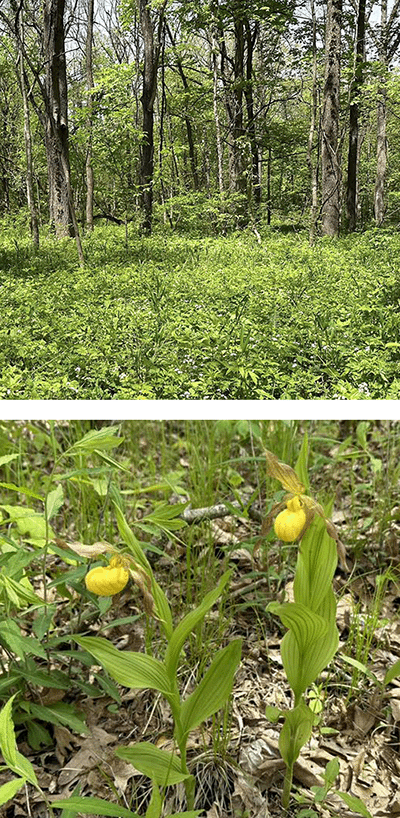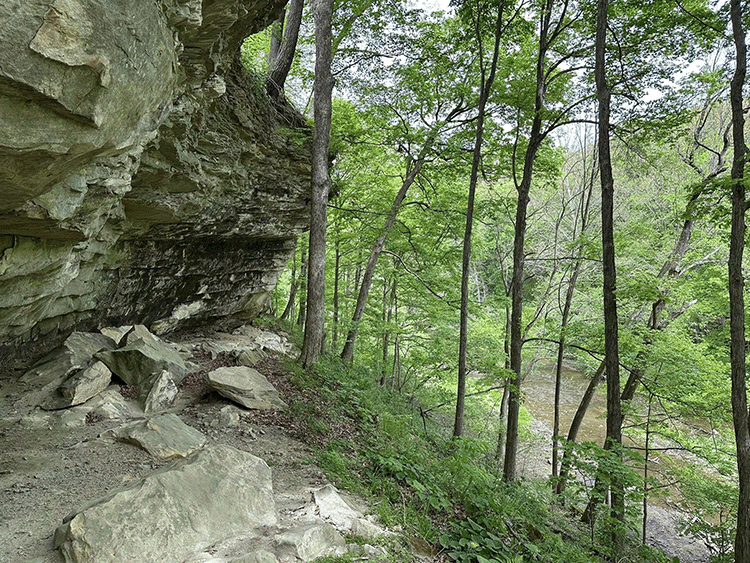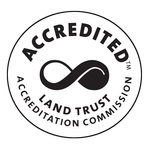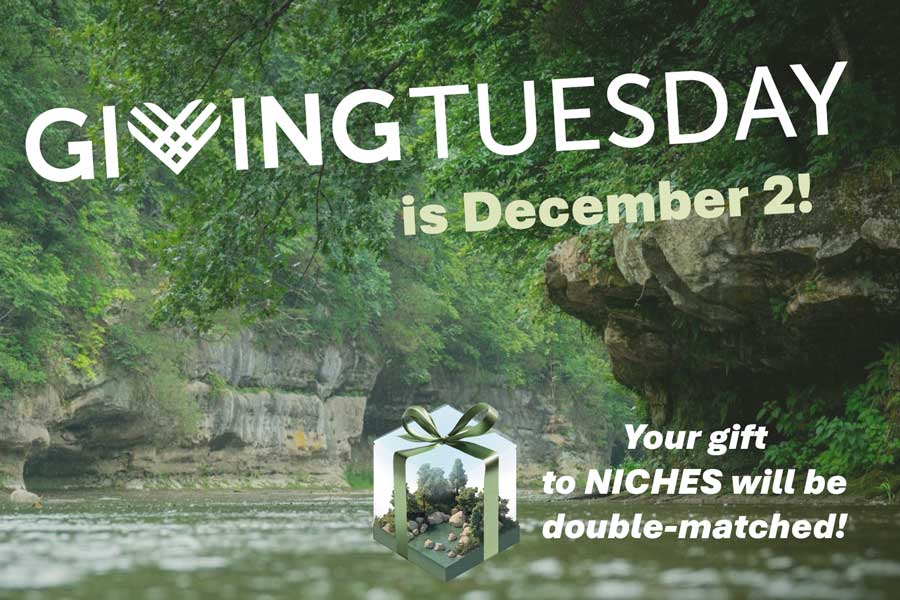News
Progress Update: Whistler-Hare Woods
In this blog post, Stewardship Bob Easter shares his report from another site inspection today at Whistler-Hare Woods in Fountain County.
In 2019, NICHES able to purchase this 100 acres of upland woodland with some floodplain and ravines south of Big Shawnee Creek and just a few miles upstream from our Shawnee Bottoms preserve. This special 100-acres was acquired from local farmer, Kenny Brown, with major support from The Roy Whistler Foundation, The Laura Hare Charitable Trust, President Benjamin Harrison Conservation Trust, Central Indiana Land Trust, as well as NICHES members and private supporters.
The preserve features approximately 60 acres of fantastic mature woodland with deep ravines cutting through glacial outwash soils to exposed sandstone bedrock, including a massive 5-acre promontory with a rockhouse overlooking the beautiful, clean, and vibrant Big Shawnee Creek which makes up the north boundary of the preserve. The property has a roughly 12-acre opening in the flat upland about 100 feet above the creek, which was farmed and then mostly converted to a Christmas tree farm. An adjacent 30-acre area is young woodland reverted from farming some decades ago, which was a solid thicket of 15-20ft tall invasive shrubs in the understory when we started management.
Dan DeSutter and his family have farmed many acres of the upstream farmland with cover crops and no-till acricultural practices since 1983 and the quality of the stream and its wildlife shows it with gar, northern map turtles, and yellow-bellied catfish to name a few.
 A Quick Summary of Our Work So Far at Whistler-Hare Woods:
A Quick Summary of Our Work So Far at Whistler-Hare Woods:
- In early 2021, NICHES worked with partners at the USFWS to Fecon mow a total of about 70-acres of this invasive shrub infestation on 37-acres of our property and about 33-acres across NICHES Land Trustndowners who connect Whistler-Hare Woods to NICHES Land Trust’s 41-acre Snyder-Marshall preserve to the southwest.
- While the invasives and leftover overgrown Christmas tree farm were mowed, I thinned sugar maples across the property in the understory, midstory, and some canopy trees to open up light to revive the herbaceous layer and work to regenerate oaks in some areas.
- We followed that major push with a couple of years of follow up treatment for resprouts on invasives and to remove black locust clones and reduce sassafras dominance in the young woodland area.
- Garlic mustard has been pulled regularly to keep it in check
- Prescribed fire has been used in the opening a few times, and once in the mature woods
- Smooth brome and other cool season forage grasses have been sprayed twice in the old Christmas tree farm
I was pleased overall with our progress to-date as I assessed the preserve. Because of funding opportunities favoring a quick turnaround, I probably followed the invasive mowing with tree work on extensive sassafras and black locust clones too closely in the young woodland, as their removal left the canopy wide open in places. We still have a lot of work to do to balance things out. Some areas are rough, but other areas in this portion of the property look great – these improved areas will help to heal the rough areas with expansion of abundant grasses, sedges, woodland forbs, and flowering dogwoods from seed.
The old Christmas tree farm is slowly converting to open oak woodland as the existing oaks of various ages were left standing to help lead the recovery. Work will still need to be done to help the area along, but broomsedge, large colonies of wild strawberries, bee balm, native old-field and early goldenrod and brambles are taking up space.
The mature woods have responded exceptionally to reduced sugar maples and carefully implemented prescribed fires. Significant white oak seedlings and a diverse herbaceous layer are regenerating on the large rock promontory. The glacial remnant white pines on the bluffs are healthy, and our work can hopefully get the next generation on their way. I spotted a yellow lady’s slipper up there today that has not been apparent until this year!
The ravines are loaded with a wide variety of woodland species including healthy populations of wild geranium, wild blue phlox, wood poppy, Canada waterleaf, large-flowered bellwort, woodland fescue, woodland bluegrass, long-awned wood grass, Penn sedge, Carex caryana, Carex plantaginea, and smaller pockets of more uncommon species as well as a wide variety of fern species.
It has been an honor to work to rebalance things on this beautiful preserve and find a stable ecological trajectory based on what the ecosystem is telling us.
You can see more photos from my visit in the NICHES Land Trust Facebook Group >> At the end of the images are the bird species recorded today during the inspection, a very impressive list!
Visitation Note:
This preserve is a little awkward to visit, as it is down a long lane with a few neighbors' residences and a fork to the left with another private property. We don’t have any big signs or any maintained trails, but if you want to visit just check out the property's webpage to see a map. Shawnee Bottoms is right down the road if you prefer a site with a parking lot and maintained trails. Please respect the preserve and our neighbors by being prepared and having a plan!
- Bob Easter, Stewardship Director, NICHES Land Trust




